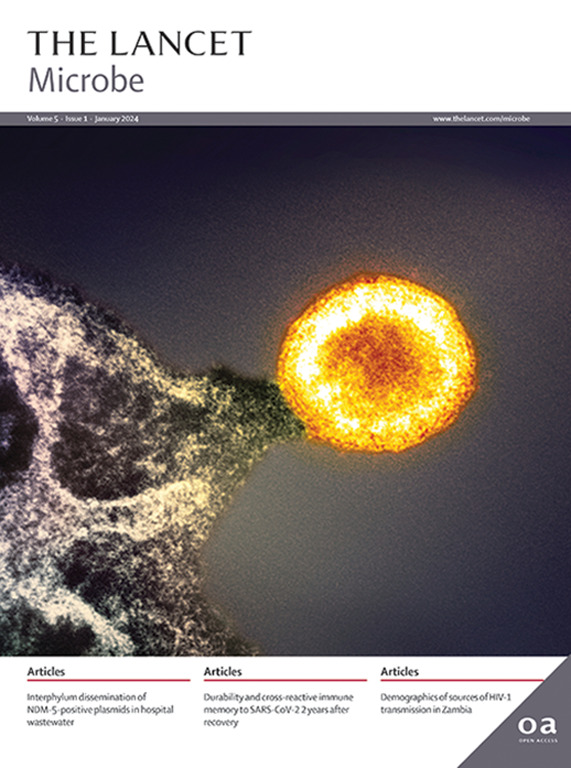Whole-genome sequencing, strain composition, and predicted antimicrobial resistance of Streptococcus pneumoniae causing invasive disease in England in 2017–20: a prospective national surveillance study
IF 20.4
1区 生物学
Q1 INFECTIOUS DISEASES
引用次数: 0
Abstract
Background
Surveillance of the invasive disease burden caused by Streptococcus pneumoniae in England is performed by the UK Health Security Agency (UKHSA). In 2017, UKHSA switched from phenotypic methods to whole-genome sequencing (WGS) approaches for pneumococcal surveillance. Here, we present the first results of national WGS surveillance, up to the start of the COVID-19 pandemic, with the aim of describing the population genomics of this important pathogen.
Methods
We examined prospective national surveillance data from England, using bacterial isolates from cases of invasive pneumococcal disease (IPD) submitted to the national reference laboratory at UKHSA. A bioinformatic pipeline was developed to quality control WGS data and routinely report species and serotype. We assembled isolate data, assigned global pneumococcal sequencing clusters (GPSCs), and predicted antimicrobial resistance (AMR) profiles for isolates that passed further quality control. We collected additional data on patient outcomes and characteristics using enhanced surveillance questionnaires completed by patients’ general practitioners. We used logistic regression analysis to assess the effects of various genomic and patient characteristics on the outcomes of IPD.
Findings
In England, between July 1, 2017, and Feb 29, 2020, there were 15 400 cases of IPD. From these cases, 13 749 (89·3%) isolates were sequenced, passed quality control, and were included in analyses. Serotype diversity was high during the study period, with 2751 (20%) isolates serotyped as 13-valent pneumococcal conjugate vaccine (PCV13) types, whereas serotype 8 was the most prevalent serotype (n=3074 [22·4%]) overall. There were 157 GPSCs within the collection, with GSPC3 the most common, encompassing 98·7% (3033 of 3074) of serotype 8 isolates. Most isolates (n=10 198 [74·2%]) did not contain AMR-associated genes. Resistance to co-trimoxazole was the most frequently predicted resistance (n=2331 [17%]), followed by resistance to tetracycline (n=1199 [8·7%]) and β-lactams (n=1149 [8·4%]). Logistic regression analysis found the presence of AMR-associated genes significantly increased the odds of patient death (odds ratio 1·18, 95% CI 1·01–1·38). Some GPSCs were also associated with a significant increase in the odds of patient death, such as GPSC12 (1·88, 1·48–2·38). Isolates from 2018 were associated with a significant increase in the odds of patient death (1·12, 1·00–1·25), whereas younger patient age was significantly associated with a reduction in the odds of patient death compared with being aged 85 years or older.
Interpretation
WGS-based surveillance has allowed us to interrogate country-wide population dynamics driving changes in pneumococcal serotype frequency. Here, we observe a stable but diverse population before the COVID-19 pandemic restrictions were enforced in England, with low rates of AMR. These findings will provide the baseline for pandemic and post-pandemic data, to collectively inform implementation and development of the vaccination programme within the country.
Funding
None.
2017- 2020年英国引起侵袭性疾病的肺炎链球菌的全基因组测序、菌株组成和预测耐药性:一项前瞻性国家监测研究
背景:由英国卫生安全局(UKHSA)对英格兰肺炎链球菌引起的侵袭性疾病负担进行监测。2017年,UKHSA从表型方法转向全基因组测序(WGS)方法进行肺炎球菌监测。在此,我们介绍了截至COVID-19大流行开始的国家WGS监测的第一批结果,目的是描述这一重要病原体的群体基因组学。方法:我们检查了来自英国的前瞻性国家监测数据,使用了从提交给UKHSA国家参考实验室的侵袭性肺炎球菌病(IPD)病例中分离出来的细菌。建立了生物信息学管道,对WGS数据进行质量控制,并定期报告物种和血清型。我们收集了分离物数据,分配了全球肺炎球菌测序簇(GPSCs),并预测了通过进一步质量控制的分离物的抗菌素耐药性(AMR)谱。我们使用由患者全科医生完成的强化监测问卷收集了关于患者结局和特征的额外数据。我们使用逻辑回归分析来评估各种基因组和患者特征对IPD结果的影响。结果:在英国,2017年7月1日至2020年2月29日期间,共有15400例IPD病例。其中13 749株(89.3%)分离物测序,通过质量控制,纳入分析。在研究期间,血清型多样性较高,共有2751株(20%)分离株血清型为13价肺炎球菌结合疫苗(PCV13)型,而血清8型是最常见的血清型(n=3074株[22.4%])。共有157株GPSCs,其中以GSPC3最为常见,占8血清型分离株的98.7%(3074株中的3033株)。大多数分离株(n=10 198株[74.2 %])不含amr相关基因。预测耐药最多的是复方新诺明(n=2331[17%]),其次是四环素(n=1199[8.7%])和β-内酰胺(n=1149[8.4%])。Logistic回归分析发现,amr相关基因的存在显著增加了患者死亡的几率(优势比1.18,95% CI 1.01 - 1.38)。一些GPSCs也与患者死亡几率的显著增加相关,如GPSC12(1.88, 1.48 - 2.38)。2018年的分离株与患者死亡几率显著增加相关(1.12,1.00 - 1.25),而与85岁或以上的患者相比,较年轻的患者年龄与患者死亡几率降低显著相关。基于wgs的监测使我们能够询问全国范围内驱动肺炎球菌血清型频率变化的人口动态。在这里,我们观察到在英格兰实施COVID-19大流行限制之前,人口稳定但多样化,AMR率较低。这些调查结果将为大流行和大流行后的数据提供基线,共同为该国疫苗接种规划的实施和发展提供信息。资金:没有。
本文章由计算机程序翻译,如有差异,请以英文原文为准。
求助全文
约1分钟内获得全文
求助全文
来源期刊

Lancet Microbe
Multiple-
CiteScore
27.20
自引率
0.80%
发文量
278
审稿时长
6 weeks
期刊介绍:
The Lancet Microbe is a gold open access journal committed to publishing content relevant to clinical microbiologists worldwide, with a focus on studies that advance clinical understanding, challenge the status quo, and advocate change in health policy.
 求助内容:
求助内容: 应助结果提醒方式:
应助结果提醒方式:


